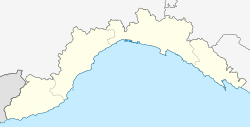Seborga
Seborga
A Seborca | |
|---|---|
| Comune di Seborga | |
 Seborga | |
| Coordinates: 43°49′34″N 7°41′40″E / 43.82611°N 7.69444°E | |
| Country | Italy |
| Region | Liguria |
| Province | Imperia (IM) |
| Government | |
| • Mayor | Enrico Ilariuzzi |
| Area | |
• Total | 4.91 km2 (1.90 sq mi) |
| Elevation | 500 m (1,600 ft) |
| Population (31 December 2015)[2] | |
• Total | 315 |
| • Density | 64/km2 (170/sq mi) |
| Demonym | Seborghini |
| Time zone | UTC+1 (CET) |
| • Summer (DST) | UTC+2 (CEST) |
| Postal code | 18012 |
| Dialing code | 0184 |
| ISTAT code | 008057 |
| Patron saint | San Bernardo |
| Saint day | 20 August |
| Website | Official website |
Seborga (Ligurian: A Seborca)[3] is a small village and self-proclaimed principality in the region of Liguria near the French border. Administratively, it is a comune of the Italian province of Imperia. The main economic activities are horticulture and tourism. It is known for being the 'territory' of the self-proclaimed micronation the Principality of Seborga. It is one of I Borghi più belli d'Italia ("The most beautiful villages of Italy").[4]
Economy
[edit]Seborga is known in the region for its agricultural activity: in particular, cultivation and collection of olives and floriculture crops. Thanks to Seborga's publicity as a principality, tourism has expanded in recent years. The principality's historic town centre was also restored, ensuring that its charms were protected from commercial overdevelopment.
Culture
[edit]An important cultural event in Seborga is the annual festival of Saint Bernard, the town's patron saint, held on 20 August. The festival includes a procession of citizens and the carrying of a statue of Saint Bernard.[5]
Seborga's twin city is L'Escarène, France.
Transport
[edit]Seborga is situated along Provincial Road 57 in Imperia. The nearest motorway access is at the Bordighera exit on the A10. The nearest railway station is also the one in Bordighera, on the Ventimiglia-Genoa line.
Principality of Seborga
[edit]
In 1964, Giorgio Carbone, then head of the local flower growers' co-operative, began promoting the idea that Seborga and its surrounding territory should become independent from Italy. Carbone claimed that Seborga had existed as a sovereign state of Italy since 954, and that from 1079 it was a principality of the Holy Roman Empire. According to Carbone's claims, Seborga was not included in the 1861 Italian unification, and that it should be recognised as a sovereign principality.[6][7][8]
In 1963 the people of Seborga held an informal vote and elected Carbone as their ostensible head of state. He then assumed the self-styled title His Tremendousness (Sua Tremendità) Giorgio I, Prince of Seborga.[9][6] Carbone remained in office until his death in 2009.[10][6] A successor, Marcello Menegatto, was elected in 2010.[11][12] Menegatto resigned in 2019 from his position, and he was succeeded by his ex-wife, Nina Menegatto, who has styled herself Her Serene Highness Princess Nina.[13]
Supporters of the independence claim promote the Principality with the trappings of a state, including the creation of a flag, the minting of coins, the formation of a "border guard" and the installation of sentry boxes on the unofficial border crossing on the main road into Seborga.[11][14][15] An official Principato di Seborga website asserts the historical arguments put forward by Carbone.[16] The independence claims of a "Principality of Seborga" have not been recognised internationally, and Seborga remains officially part of Italy.
See also
[edit]- Passport to Pimlico (1949)
- Cooking up a Country (2018)
References
[edit]- ^ "Superficie di Comuni Province e Regioni italiane al 9 ottobre 2011". Italian National Institute of Statistics. Retrieved 16 March 2019.
- ^ All demographics and other statistics from the Italian statistical institute (Istat)
- ^ Frisoni, Gaetano [in Italian] (1910). Dizionario Genovese-Italiano e Italiano-Genovese (in Italian). Genova: Nuova Editrice Genovese.
- ^ "Liguria" (in Italian). Retrieved 31 July 2023.
- ^ Principato di Seborga (2016-08-22), Festa di San Bernardo 2016 - 20/08/16, archived from the original on 2021-12-15, retrieved 2016-10-12
- ^ a b c "Obituary: His Tremendousness Giorgio Carbone". The Telegraph. 27 November 2009. Archived from the original on 1 December 2009. Retrieved 17 January 2021.
- ^ Klieger, P. Christiaan (29 November 2012). The Microstates of Europe: Designer Nations in a Post-Modern World. Lexington Books. p. 177. ISBN 978-0-7391-7427-2. Retrieved 17 January 2021.
- ^ Moore, Malcolm (13 June 2006). "Battle rages for His Tremendousness's throne | Italy | Europe | International News | News | Telegraph". The Telegraph. Archived from the original on 11 March 2007. Retrieved 17 January 2021.
- ^ "Prince of Seborga fights on for 362 subjects | Liguria | ITALY Magazine". The Telegraph. 15 June 2006. Archived from the original on 19 November 2010. Retrieved 17 January 2021.
- ^ Martin, Douglas (12 December 2009). "Giorgio Carbone, Elected Prince of Seborga, Dies at 73 (Published 2009)". The New York Times. Archived from the original on 9 November 2020. Retrieved 3 February 2021.
- ^ a b Squires, Nick (27 April 2010). "Tiny Italian principality announces new monarch called 'His Tremendousness'". The Daily Telegraph. Retrieved 18 June 2010.
- ^ "The King of Nylon: 'kingdom' of Seborga ruled by hosiery heir". The Metro. London. 28 April 2010. Retrieved 18 June 2010.
- ^ Vogt, Andrea (10 November 2019). "'Her Tremendousness' elected leader of self-declared micro-nation on hilltop in Italy". The Daily Telegraph. Retrieved 11 November 2019.
- ^ Mikelbank, Peter (9 February 1997). "BORDERLINE INSANITY?". Washington Post. Retrieved 3 February 2021.
- ^ "Le Guardie". Principato di Seborga (in Italian). Archived from the original on 9 January 2021. Retrieved 17 January 2021.
- ^ "Storia". Principato di Seborga (in Italian). Governo del Principato di Seborga. Archived from the original on 9 January 2021. Retrieved 17 January 2021.





